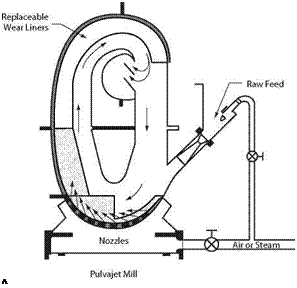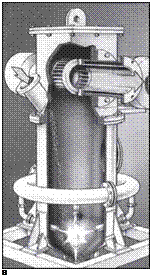Another method of keeping balls in motion at high speed is nutation, which is similar to the oscillation of a spinning top. The nutating action, shown in Figure 8.9, is used by the Hicom mill.
The grinding chamber is a truncated cone with a roughly hemispherical base, on a vertical axis of symmetry. The chamber axis “nutates” about a fixed point defined by the main bearing, the motion being similar to that of a conical pendulum in which the top is fixed and the bottom describes a circle. (Hicom International 2001)
Hicom reports that the nutating mill has a power density of up to 2,500 kW/m3 of mill volume and to give very high rates of breakage.
JET MILLS
The underlying principle of all jet action fluid energy mills is to induce particles to collide with each other at high velocity causing one or both to fracture into smaller particles. Multiple collisions enhance the reduction process and, therefore, multiple jet arrangements are normally incorporated in the mill design. (Grim — shaw and Albus 1983)
Jet milling is a low-volume process that has been used since the 1950s for making high — value, ultrafine materials. It is expensive compared with higher-volume processes so it is
 |
 |
only used for special applications. Some examples of products for which jet milling is suitable are
■ Highly pure substances such as fluorescent powders and silica gels
■ Abrasive materials such as tungsten or silicon carbide, and aluminum or zirconium oxide
■ Powder coatings for thin film application
■ Toners for photocopying machines and laser printers
■ New ceramic materials
■ Rare earths for the manufacture of magnets
■ Contamination-free dental cement
■ Fine industrial minerals that form flakes or needles
■ Thermoplastics
■ Temperature-sensitive substances such as waxes or resins
One type of jet mill is the older vertical loop mill shown in Figure 8.10a; another is the fluidized-bed jet mill shown in Figure 8.10b. In the vertical loop mill, the jet of fluid and particles enters at high velocity and passes a further series of jets that increase the probability of collision and breakage. Centrifugal action as the particles flow around the loop retains the coarse particles at the wall, and they reenter the breakage zone while the fine particles leave the unit through a center opening. In the fluidized-bed jet mill, high-velocity streams of particles suspended in a gas collide in a core breakage zone and, after leaving the core zone, form a bed that is fluidized by the gas. The fine particles are swept out of the bed by the gas and are classified in the rotating cage, the ultrafine particles leave the mill, and the coarser particles are returned to the fluidized bed and the breakage zone for further grinding.
The velocity of the jets is very high to ensure that the particles have sufficient momentum to break when they collide. The range of velocities through the nozzles is 500-1,000 m/sec and in the breakage zone is 200-400 m/sec.
The velocity of the driving fluid exiting the nozzles is directly proportional to the square root of the absolute temperature entering the nozzles, thus to obtain maximum energy from a given mass of fluid it is desirable to elevate the incoming temperature to the maximum tolerance temperature of the feed material. …Optimum size reduction is achieved by the use of high pressure, superheated steam, generally in the range of 13.8-20.7 bars and 315-370 degrees C. (Grimshaw and Albus 1983)
CONCLUSION
The demand for ultrafine products with even greater fineness will continue, and the value of these products justifies the use of individualized size-reduction processes and machinery.
This chapter completes the history of the development of methods and machinery for size reduction. Because it is often necessary to “classify” the discharge from the size — reduction machine—to obtain the desired results and control performance—we turn next to a brief historical review of size classification as used in size reduction.
Copyright © 2005 by the Society for Mining, Metallurgy, and Exploration.
All rights reserved. Electronic edition published 2009.
